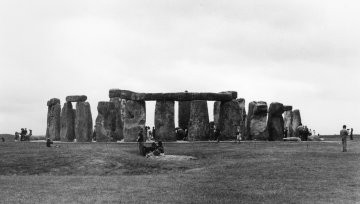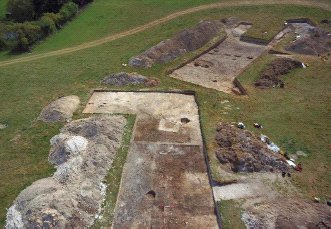Stonehenge settlement
The remains of a prehistoric village lie near the legendary stone circle in England known as Stonehenge.
By Emily Sohn
Stonehenge has mystified visitors for thousands of years. Somehow, about 4,600 years ago, people managed to haul humongous stones across southern England to a site on the Salisbury Plain. There, they erected a large circular structure. Some of the stones are more than 13 feet tall and weigh at least 25 tons.
Scientists and historians have long wondered not only how people built Stonehenge, but also why. Now, recent discoveries offer some answers. Scientists from the University of Sheffield in England and their coworkers propose that the structure was part of a religious complex dedicated to the dead.
 |
|
Built more than 4,000 years ago in southern England, Stonehenge’s circle of tall, massive stones may have been used to keep track of astronomical events and to honor the dead. This photo was taken in 1973, when visitors were still allowed to wander among the rocks.
|
| Photo by I. Peterson. |
The team has been excavating an ancient village called Durrington Walls, 2 miles downriver from Stonehenge. This site is an example of a henge, which means that it’s surrounded by a ditch and a raised bank of earth.
Previously, scientists working there had found evidence of dozens of hearths, marking where people lived and cooked. Searching stopped in 1967, however. The Sheffield team revived the effort in 2003.
“We think we’re looking at a village that was occupied by the builders of Stonehenge,” says lead researcher Michael Parker Pearson.
 |
|
Excavations in England reveal clay floors of prehistoric houses at a site that may have been occupied by the builders of Stonehenge. One work area, floor at upper right, cuts across the remains of a road that ran to a nearby river.
|
| A. Stanford/Aerial-Cam for National Geographic |
In September, the researchers dug up the remains of eight houses. Each house measured about 16 feet by 16 feet, with clay floors and a fireplace in the middle.
Holes and slots in the floors revealed where furniture used to stand. Large numbers of animal bones and leftover cooking utensils suggest that the villagers held large feasts in the buildings. Analyses showed that the houses were about the same age as human remains found at Stonehenge.
The houses at Durrington Walls sat next to a road made of stone, which researchers discovered in 2005. Measuring 90 feet wide and 560 feet long, the road ran between the River Avon and a circle of trees, which was most likely used for ceremonies. Two miles upstream, a similar road ran between the river and Stonehenge.
Both the Durrington Walls road and the Stonehenge road were aligned with the position of sunrise or sunset on the longest day of the year, in June. And both a circle of trees at Durrington Walls and a set of three giant stones at Stonehenge frame the sunrise or sunset on the shortest day of the year, in December.
Parker Pearson’s team envisions the villagers celebrating life at Durrington Walls before carrying their dead to Stonehenge. There, they would have cremated and buried their loved ones. The massive stones symbolized the permanence of the afterlife and served as memorials to the dead.
To confirm this theory, the scientists will need to find more evidence of graves and funeral rituals. They plan to keep looking for such evidence until at least 2010. —E. Sohn
Going Deeper:
Bower, Bruce. 2007. Suburb of Stonehenge: Ritual village found near famed rock site. Science News 171(Feb. 3):67. Available at http://www.sciencenews.org/articles/20070203/fob1.asp .
To learn more about Stonehenge, go to www.english-heritage.org.uk/server/show/nav.876 (English Heritage), www.stonehenge.co.uk/ (Window on Britain), or en.wikipedia.org/wiki/Stonehenge (Wikipedia).







